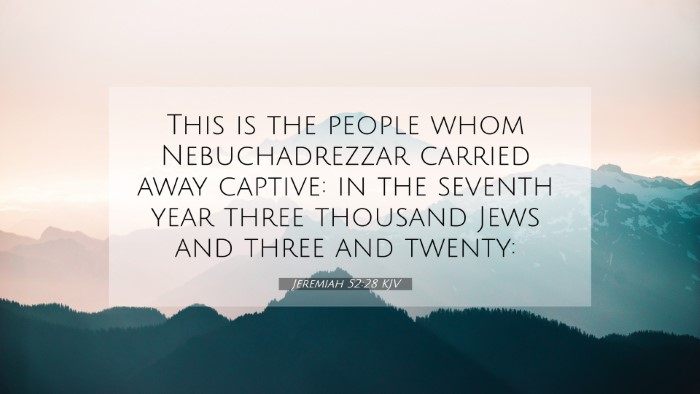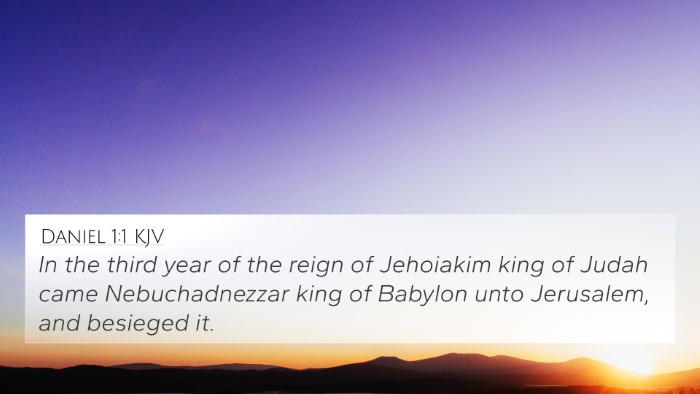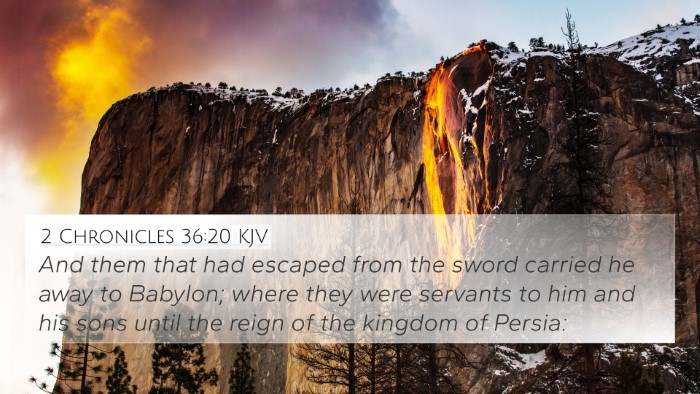Understanding Jeremiah 52:28
Jeremiah 52:28 is a significant verse within the context of the Book of Jeremiah, as it concludes the narrative of the fall of Jerusalem and the exile of its people. This verse captures a moment of historical import by listing the number of people exiled to Babylon during the Babylonian captivity.
Summary of the Verse
The verse states:
"This is the number of the people whom Nebuchadnezzar carried away captive: in the seventh year, three thousand and twenty-three Jews."
This succinctly summarizes part of the consequences of Judah's unfaithfulness, as prophesied by Jeremiah throughout the text.
Commentary Insights
- Matthew Henry: Henry emphasizes the theme of judgment and mercy, illustrating how God, despite bringing judgment upon Judah, still preserves a remnant. This remnant would be the basis for restoration.
- Albert Barnes: Barnes provides a numerical interpretation, indicating the significance of the figures as representative of a larger reality of exile and loss for the Jewish people, while also hinting at God's ultimate plan for redemption.
- Adam Clarke: Clarke elaborates on the historical context, discussing how this captive group sets the stage for future events in Jewish history, particularly the longing for return and restoration that would follow in later prophecies.
Bible Verse Cross-References
- 2 Kings 24:14 - "And he carried away all Jerusalem, and all the princes, and all the mighty men of valour, even ten thousand captives, and all the craftsmen and smiths..."
- Jeremiah 39:1-2 - Describes the siege of Jerusalem and its eventual fall to the Babylonians.
- Ezekiel 12:15 - "And they shall know that I am the Lord, when I shall scatter them among the nations, and disperse them in the countries."
- Lamentations 1:3 - Reflects the desolation experienced by Jerusalem and her people post-exile.
- Daniel 1:1-2 - Discusses the first wave of exiles taken to Babylon and the eventual rise of Daniel.
- Isaiah 39:6 - Prophecy regarding the Babylonian captivity foretold earlier in the history of Israel.
- 2 Chronicles 36:20-21 - Provides a similar account of the exile, emphasizing the fulfillment of the prophetic word regarding captivity.
- Jeremiah 25:11 - Foretells the seventy years of captivity that would come as a result of Israel's disobedience.
- Zechariah 1:12 - Points to God's judgment yet also His plans for restoration.
- Haggai 1:1 - Relates to the period after the Israelites return from exile and rebuild the temple, which is deeply connected to Jeremiah's prophecies.
Thematic Bible Verse Connections
The themes in Jeremiah 52:28 are echoed throughout the scriptures, showcasing the cyclical nature of judgment and restoration in the Biblical narrative.
- Covenant Relationship: The disobedience leading to exile emphasizes the importance of maintaining one's covenant relationship with God.
- Prophetic Fulfillment: Jeremiah's prophetic voices resonate through these historical accounts, showing the accuracy of God's word concerning His people.
- Hope of Restoration: Despite the captivity, the subsequent verses in the prophetic books reveal God's promise to restore His people.
- Historical Judgment: The consequences of sin manifest historically, reminding readers of the serious effects of turning away from God.
- Divine Sovereignty: Even in judgment, God's control over nations is evident, as He directs the course of history.
Cross-Referencing Biblical Texts
The act of cross-referencing Bible verses related to Jeremiah 52:28 allows believers to see the interconnectedness of God's word. Tools for Bible cross-referencing, such as concordances and Bible study guides, can enrich one’s study and understanding of scripture.
Tools for Bible Cross-Referencing
For those looking to delve deeper into Biblical studies, employing resources like a Bible concordance or a cross-reference Bible system can enhance your grasp of scriptural truths.
- Utilizing a cross-reference guide to trace similar themes in the scriptures.
- Engaging in cross-referencing Bible study methods to explore the links between Old and New Testament writings.
- Identifying patterns in the narratives of exile and restoration across various Biblical books.
- Cross-referencing Psalms with prophetic themes in other texts enhances understanding of the poetic expressions of despair and hope.
- Exploring inter-Biblical dialogue that sheds light on the fulfillment of promises from prophetic books in the New Testament.
Conclusion
Jeremiah 52:28, while a brief statement regarding the exile, serves as a focal point for understanding the larger narrative of sin, judgment, and ultimate restoration found throughout both the Old and New Testaments. By cross-referencing this verse with others, one can engage in a deeper study that highlights the consistency and faithfulness of God’s word throughout history.






